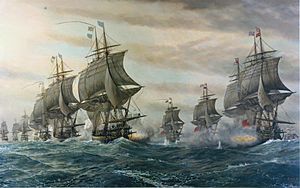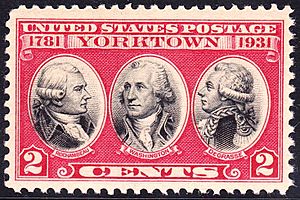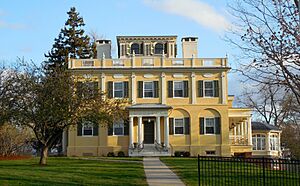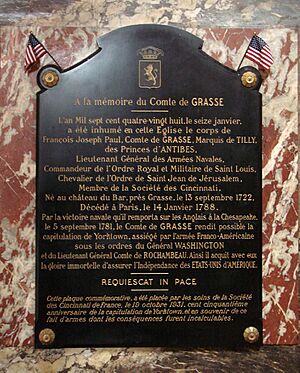François Joseph Paul de Grasse facts for kids
Quick facts for kids
François Joseph Paul de Grasse
|
|
|---|---|
 |
|
| Nickname(s) | Comte de Grasse |
| Born | 13 September 1722 Le Bar-sur-Loup, Provence, France |
| Died | 11 January 1788 (aged 65) Tilly, Île-de-France, France |
| Buried |
Church of Saint-Roch, Paris
|
| Allegiance | |
| Service/ |
|
| Years of service | 1734–1784 |
| Rank | Lieutenant général des armées navales |
| Battles/wars | |
| Signature | |
François Joseph Paul, also known as Comte de Grasse, was a brave French naval officer. He became an admiral and is famous for his role in the American Revolutionary War. In 1781, he led the French fleet to victory at the Battle of the Chesapeake. This important battle helped the American colonists win their independence from Britain at Yorktown.
After this success, de Grasse sailed his fleet back to the Caribbean. In 1782, he was defeated and captured by British Admiral Rodney at the Battle of the Saintes. This loss was a difficult moment in his career.
Contents
Early Life and Family
François-Joseph de Grasse was born on September 13, 1722, in Le Bar-sur-Loup, a town in southeastern France. He was the youngest child of Francois de Grasse Rouville. He inherited his title, Comte de Grasse, and helped support his family from the Provence region.
De Grasse married Antoinette Rosalie Accaron in 1764. They had six children who grew up, including his oldest son, Alexandre Francois Auguste de Grasse. Auguste later became a count like his father. De Grasse also had four daughters: Amélie, Adélaide, Melanie, and Silvie. Silvie later moved to New York City with her husband.
De Grasse married two more times after Antoinette passed away. His second wife was Catherine Pien, and his third was Marie Delphine Lazare de Cibon.
While serving in India, de Grasse also had a son named George de Grasse. George was born around 1780. De Grasse brought George back to Paris for his education and officially adopted him. George later moved to the United States and became a citizen. His children achieved great things: his son John van Salee de Grasse became the first African American to graduate from medical school, and his daughter Serena married George T. Downing, a well-known civil rights activist.
De Grasse began his naval journey at a young age. When he was eleven, in 1734, he joined the Order of Saint John. He served on galleys (ships powered by oars) and fought against the Turks and Moors. In 1740, at age 17, he officially joined the French Navy.
He took part in French naval actions in India during the Seven Years' War. After Britain won this war, de Grasse helped to rebuild the French navy.
Fighting in the American War of Independence

In 1775, the American Revolutionary War began. American colonists were fighting for their freedom from British rule. France secretly helped the colonists at first. Then, in 1778, France officially joined the war as an ally of the Americans.
De Grasse served as a commander in several battles. In 1778, he fought in the First Battle of Ushant off the coast of France. In 1779, he joined the French fleet in the Caribbean. He helped capture Grenada and fought in battles against British Admiral Rodney near Martinique.
In March 1781, de Grasse was promoted to lieutenant-general of the Navy, which is like a vice-admiral. He then successfully defeated British Admiral Samuel Hood and captured the island of Tobago.
Victory at Chesapeake and Yorktown

In 1781, American General George Washington and French General Comte de Rochambeau asked de Grasse for help. De Grasse sailed with 3,000 troops from Saint-Domingue (now Haiti) to Virginia.
He then won a very important battle against the British fleet at the Battle of the Chesapeake in September 1781. This victory meant that the British navy could not help their army. De Grasse blocked the coast, trapping British General Charles Cornwallis at Yorktown. Cornwallis soon surrendered, which helped the United States become an independent nation.
Defeat at the Saintes
After his success, de Grasse returned his fleet to the Caribbean. However, he faced a difficult defeat in 1782. He was first defeated by Admiral Hood at the Battle of St. Kitts.
Soon after, in April 1782, de Grasse was defeated again and captured by Admiral Rodney at the Battle of the Saintes. He was taken to London for a time. While there, he helped with talks that led to the Peace of Paris (1783), which ended the American Revolutionary War.
When de Grasse returned to France, some people criticized him for the defeat. He asked for a formal inquiry, and in 1784, most of the officers involved were cleared of blame.
Later Life and Legacy
De Grasse was honored as a Commander of the Order of St. Louis and a Knight of the Order of St. John of Jerusalem. He was also a member of the American Society of the Cincinnati.
Admiral de Grasse passed away in 1788 at Tilly, France. His tomb is located in the church of Saint-Roch in Paris.
His children later moved to Saint-Domingue. His oldest son, Auguste de Grasse, inherited his father's title. Auguste later returned to France and continued his military career in the army. He also wrote a book about his father and his own travels.
Memorials and Honors
Many places and things have been named in honor of Admiral de Grasse:
- A monument stands at the Cape Henry Memorial in Virginia Beach, Virginia, to remember Admiral de Grasse and his sailors.
- A statue of Admiral de Grasse is located at the riverwalk in Yorktown, Virginia.
- Another statue of him can be found in his hometown of Le Bar-sur-Loup, France.
- The Grasse Mount estate in Burlington, Vermont, was named after him.
- A monument to Admiral de Grasse was placed at the Trocadero Palace in Paris in 1931.
- The Grasse River in St. Lawrence County, New York, and the hamlet of Degrasse are named for him.
- Two large French Line passenger ships were named De Grasse. The first was famous for transatlantic travel and was used as a troop ship in World War II.

Vessels Named After De Grasse
The French Navy has named two ships in his honor:
- An anti-aircraft cruiser (in service from 1956 to 1973).
- A first-rank frigate (a type of warship).
The United States Navy has also named three vessels after him:
- USS Comte de Grasse (DD-974), a large destroyer (commissioned 1978, decommissioned 1998).
- USS De Grasse (AP-164/AK-223), a cargo ship used during World War II.
- USS De Grasse (ID-1217), a patrol boat used in 1918.
Images for kids
See also
 In Spanish: François Joseph Paul de Grasse para niños
In Spanish: François Joseph Paul de Grasse para niños



